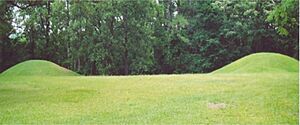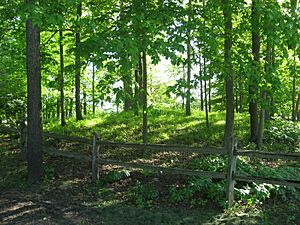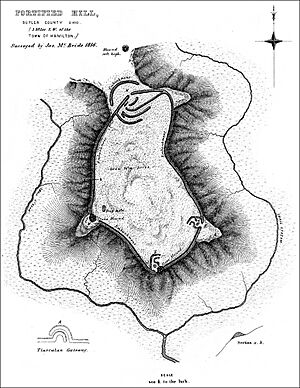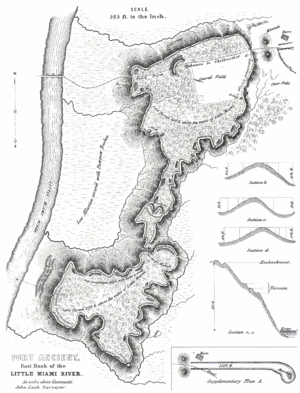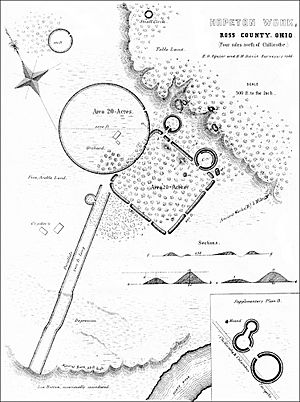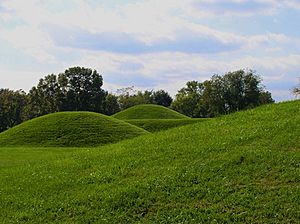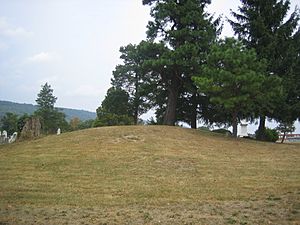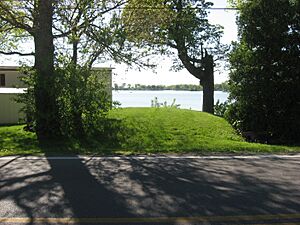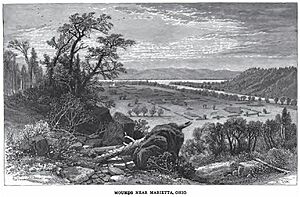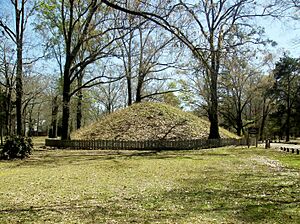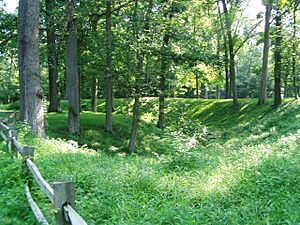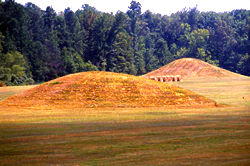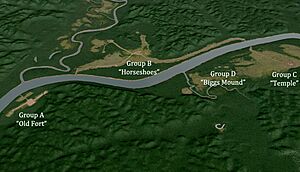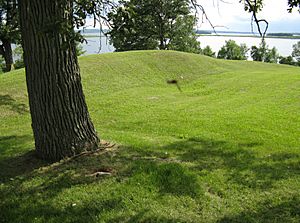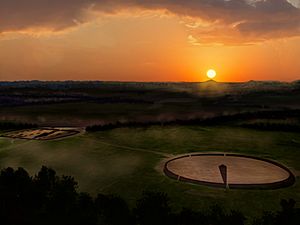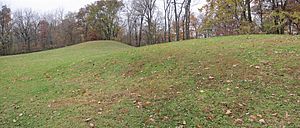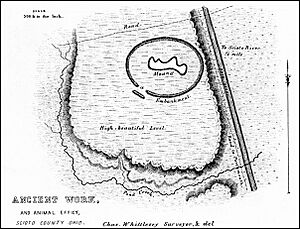List of Hopewell sites facts for kids
The Hopewell tradition (also called the "Hopewell culture") refers to the common ways of life among Native American groups. These groups thrived along rivers in the northeastern and midwestern United States from about 200 BCE to 500 CE. The Hopewell tradition wasn't a single culture or society. Instead, it was a group of related communities spread out over a large area. They were connected by a shared network of trade routes, known as the Hopewell Exchange System. This list explores some of the important places where the Hopewell people lived and built things.
Contents
- Discovering Hopewell Sites
- Bynum Mound and Village Site
- Cloverdale Archaeological Site
- Crooks Mound
- Dunns Pond Mound
- Fortified Hill Works
- Fort Ancient (Lebanon, Ohio)
- Grand Gulf Mound
- Hopeton Earthworks
- Hopewell Culture National Historical Park
- Hopewell Mound Group
- Indian Mound Cemetery
- Junction Group
- Kolomoki Mounds Historic Park
- Lake Ridge Island Mounds
- Leake Mounds
- Lewiston Mound
- Mann Site
- Marietta Earthworks
- Marksville Prehistoric Indian Site
- Moorehead Circle
- Mounds State Park
- Newark Earthworks
- Oak Mounds
- Pharr Mounds
- Portsmouth Earthworks
- Renner Village Archeological Site
- Seip Earthworks and Dill Mounds District
- Serpent Mounds Park
- Shriver Circle Earthworks
- Sinnissippi Mounds
- Toolesboro Mound Group
- Tremper Mound and Works
- Trowbridge Archaeological Site
- See also
Discovering Hopewell Sites
Bynum Mound and Village Site
This site is located near Houston, Mississippi. It features six cone-shaped mounds. These mounds were built and used during the Miller 1 and Miller 2 phases of the Miller culture (100 BCE to 100 CE). The site was added to the National Register of Historic Places in 1989.
Cloverdale Archaeological Site
The Cloverdale site (23BN2) is an important place near St. Joseph, Missouri. It sits at the opening of a small valley leading to the Missouri River. Kansas City Hopewell people lived here from about 100 to 500 CE. Later, from 1000-1250 CE, Steed-Kisker people also lived there. These were farming people who likely came from Cahokia.
Crooks Mound
This is a Marksville culture mound site in La Salle Parish, Louisiana. It's a large, cone-shaped burial mound. People were buried here at least six different times. The mound is about 16 feet (4.9 m) high and 85 feet (26 m) wide.
Dunns Pond Mound
The Dunns Pond Mound is a historic Native American mound in northeastern Logan County, Ohio. You can find it near Huntsville, along the southeastern edge of Indian Lake. In 1974, this mound was listed on the National Register of Historic Places.
Fortified Hill Works
This is a registered historic site located near Hamilton, Ohio.
Fort Ancient (Lebanon, Ohio)
Fort Ancient is a huge collection of mounds and earthen walls. It's located in Washington Township, Warren County, Ohio, along the eastern shore of the Little Miami River. This site is the largest prehistoric hilltop enclosure in the United States. It has three and a half miles (18,000 ft or 5,500 m) of walls within a 100-acre (0.40 km2) complex.
Grand Gulf Mound
This is an Early Marksville culture site near Port Gibson in Claiborne County, Mississippi. It's on a bluff about 1 mile (1.6 km) east of the Mississippi River. The site has one burial mound that still exists, and there might have been two others in the past.
Hopeton Earthworks
The Hopeton Earthworks are a group of mounds and earthworks built by the Ohio Hopewell people. They are about a mile east of the Mound City Group, on a flat area near the Scioto River. Along with the Mound City Group, Hopeton is part of the Hopewell Culture National Historical Park.
Hopewell Culture National Historical Park
This park, once called Mound City Group National Monument, is a United States national historical park. It protects earthworks and burial mounds from the Hopewell culture. The Hopewell people lived here from about 200 BCE to 500 CE. The park includes six separate sites in Ross County, Ohio.
Hopewell Mound Group
The Hopewell Mound Group is very important because the entire Hopewell culture is named after it. It's one of the six sites that make up the Hopewell Culture National Historical Park. This group of mounds and earthwork enclosures is located a few miles west of Chillicothe, on the north bank of Paint Creek.
Indian Mound Cemetery
Indian Mound Cemetery is in Romney, West Virginia. It's built around a Hopewell mound. The mound is seven feet high and about fifteen feet wide. It's the largest remaining earthwork mound in West Virginia's Eastern Panhandle. The city of Romney has never allowed the mound to be dug up. Experts think this mound might be from between 500 and 1000 CE.
Junction Group
This is an earthworks site located in Ross County, Ohio.
Kolomoki Mounds Historic Park
The Kolomoki Mounds are Woodland Period mounds in Early County, Georgia. The seven earthwork mounds at this park were built between 250-950 CE. They were created by people of the Swift Creek and Weeden Island cultures.
Lake Ridge Island Mounds
The Lake Ridge Island Mounds (also called the Wolf Mounds I-IV) are a group of small hills in Logan County, Ohio. People believe these hills are Native American mounds. They are located on Lake Ridge Island in Indian Lake.
Leake Mounds
Leake Mounds is an archaeological site in Bartow County, Georgia. It was built and used by people of the Swift Creek Culture.
Lewiston Mound
This is a burial mound located in Lewiston, New York, in Niagara County, New York. The Earl W. Brydges Artpark State Park has been built around it, helping to protect the mound.
Mann Site
The Mann site (12 Po 2) is in Posey County, Indiana. It's near where the Wabash and Ohio rivers meet. Because of how big and complex its earthworks are, experts think it might have had more people living there than Hopewell sites in Ohio. It could be the largest site from this time period in the entire Midwest. It was added to the National Historic Register in 1974.
Marietta Earthworks
These earthworks are located where the Muskingum and Ohio rivers meet in Washington County, Ohio. Much of the site is now covered by the modern city of Marietta. The site once had at least four large platform mounds, three walled areas, and a big burial mound. This burial mound is now protected within the Mound Cemetery.
Marksville Prehistoric Indian Site
Also known as the Marksville State Historic Site, this is the main site for the Marksville culture. It's located about one mile southeast of Marksville, Louisiana.
Moorehead Circle
This is a triple woodhenge that was built about two thousand years ago. It's located at the Fort Ancient Earthworks in Ohio.
Mounds State Park
Mounds State Park is a state park in Anderson, Indiana. It features prehistoric Native American heritage. The park has 10 ceremonial mounds built by the Adena people. Later, Hopewell people also used these mounds.
Newark Earthworks
In Newark, Ohio, this site has three preserved sections of earthwork: the Great Circle Earthworks, the Octagon Earthworks, and the Wright Earthworks. This complex was the largest earthen enclosure in the world. The site is protected as a state park by the Ohio Historical Society.
Oak Mounds
Outside Clarksburg, West Virginia, in Harrison County, there is a large Indian mound. To its west is a smaller mound. These mounds have never been fully dug up, but they were likely built by the Hopewell culture between 0 and 1000 CE.
Pharr Mounds
Located near Tupelo, this site includes parts of Itawamba and Prentiss County, Mississippi. It's a complex of eight dome-shaped burial mounds. The site was used during the Miller 1 phase of the Miller culture and was built between 1 and 200 CE. It's considered one of the largest and most important sites from this time.
Portsmouth Earthworks
The Portsmouth Earthworks are a large mound complex built by the Ohio Hopewell culture (100 BCE to 500 CE). This site was one of the biggest ceremonial centers built by the Hopewell people. It's located where the Scioto and Ohio Rivers meet. Most of the site is now covered by the city of Portsmouth.
Renner Village Archeological Site
The Renner Village Archeological Site is an important Kansas City Hopewell culture site in Riverside, Missouri. Archaeologists call it the Renner site (23PL1). It contains artifacts from both the Hopewell and Middle Mississippian cultures. This site is one of several Kansas City Hopewell sites near where Line Creek joins the Missouri River.
Seip Earthworks and Dill Mounds District
This is a large hilltop enclosure in Ross County, Ohio. It is one of the sites that make up the Hopewell Culture National Historical Park.
Serpent Mounds Park
This park should not be confused with the Serpent Mound in Adams County, Ohio. The site was built by the Point Peninsula complex peoples. These were Hopewellian people who lived in central and southeastern Ontario, southwestern Quebec, and northern parts of New York state between 300 BCE and 700 CE.
Shriver Circle Earthworks
The Shriver Circle Earthworks (33 RO 347) are an Ohio Hopewell culture archaeological site. They are located in Chillicothe in Ross County, Ohio. At 1,200 feet (370 m) across, this site is one of the largest circular enclosures built by the Hopewell in Ohio.
Sinnissippi Mounds
The Sinnissippi Mounds are a group of Havana Hopewell culture burial mounds. They are located in the city of Sterling, Illinois, United States.
Toolesboro Mound Group
This is a Havana Hopewell culture site. The Toolesboro Mound Group is a collection of mounds on the north bank of the Iowa River, near where it flows into the Mississippi. The State Historical Society of Iowa owns these mounds and displays them to the public. The mounds are east of Wapello, Iowa, near the community of Toolesboro.
Tremper Mound and Works
The Tremper Mound and Works are an Ohio Hopewell (100 BCE to 500 CE) earthen enclosure and a large, oddly shaped mound. It was added to the National Register of Historic Places in 1972. The site is in Scioto County, Ohio, about five miles northwest of Portsmouth, Ohio. It sits on a raised floodplain overlooking the Scioto River.
Trowbridge Archaeological Site
The Trowbridge Archaeological Site is located near North 61st Street and Leavenworth Road in Kansas City, Kansas. The Kansas City Hopewell culture lived here from about 200–600 CE.
See also


